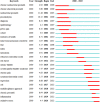A Bibliometric Analysis of Urologic Chronic Pelvic Pain Syndrome From 2000 to 2022
- PMID: 37064957
- PMCID: PMC10103784
- DOI: 10.2147/JPR.S396009
A Bibliometric Analysis of Urologic Chronic Pelvic Pain Syndrome From 2000 to 2022
Abstract
Purpose: Urologic chronic pelvic pain syndrome has attracted a lot of attention in the new century, and an increasing number of relevant studies have been published. Therefore, we performed a bibliometric analysis of these publications, hoping to show the current research hotspots and future research trends.
Methods: The articles on were selected from the Web of Science Core Collection. Countries, authors, references and keywords in the field were visualized and analyzed using CiteSpace and VOSViewer software.
Results: A total of 1014 articles on urologic chronic pelvic pain syndrome were identified, with "chronic pelvic pain syndrome" being the most common keyword, with a strong association with "interstitial cystitis" and "chronic prostatitis". The hotspot of urologic chronic pelvic pain syndrome research has gradually shifted from chronic prostatitis / urologic chronic pelvic pain syndrome to cystitis/bladder pain syndrome over the past few years. Future research tends to focus on urologic chronic pelvic pain syndrome etiology, including oxidative stress and inflammation.
Conclusion: Research on urologic chronic pelvic pain syndrome is steadily growing. The United States has made the most prominent contribution in this area, and the share of China's contribution is expected to grow further. The etiology of urologic chronic pelvic pain syndrome, including inflammation and oxidative stress, have been the focus of current research and developmental trends in the future research.
Keywords: bibliometric analysis; chronic pelvic pain syndrome; chronic prostatitis; interstitial cystitis; mechanisms; treatments.
© 2023 Wang et al.
Conflict of interest statement
Jie Wang and Bin Cao share first authorship. The authors declared that they have no conflict of interest.
Figures










Similar articles
-
Knowledge domain and emerging trends in chronic prostatitis/chronic pelvic pain syndrome from 1970 to 2020: a scientometric analysis based on VOSviewer and CiteSpace.Ann Palliat Med. 2022 May;11(5):1714-1724. doi: 10.21037/apm-21-3068. Epub 2022 Feb 9. Ann Palliat Med. 2022. PMID: 35144392
-
Research Trends of Acupuncture Therapy on Chronic Pelvic Pain Syndrome from 2000 to 2022: A Bibliometric Analysis.J Pain Res. 2023 Nov 30;16:4049-4069. doi: 10.2147/JPR.S434333. eCollection 2023. J Pain Res. 2023. PMID: 38054110 Free PMC article. Review.
-
Correlates of 1-Year Change in Quality of Life in Patients with Urologic Chronic Pelvic Pain Syndrome: Findings from the Multidisciplinary Approach to the Study of Chronic Pelvic Pain (MAPP) Research Network.J Urol. 2020 Oct;204(4):754-759. doi: 10.1097/JU.0000000000001080. Epub 2020 Apr 15. J Urol. 2020. PMID: 32294397 Free PMC article.
-
The MAPP research network: a novel study of urologic chronic pelvic pain syndromes.BMC Urol. 2014 Aug 1;14:57. doi: 10.1186/1471-2490-14-57. BMC Urol. 2014. PMID: 25085007 Free PMC article.
-
Research Trends of Acupuncture Therapy on Fibromyalgia from 2000 to 2021: A Bibliometric Analysis.J Pain Res. 2022 Dec 15;15:3941-3958. doi: 10.2147/JPR.S382847. eCollection 2022. J Pain Res. 2022. PMID: 36545405 Free PMC article. Review.
Cited by
-
Top-cited articles in andrology journals from 2013-2022: a bibliometric analysis.Int J Impot Res. 2025 May;37(5):356-360. doi: 10.1038/s41443-024-00908-4. Epub 2024 May 28. Int J Impot Res. 2025. PMID: 38806629 Review.
-
Research hotspots and trends of brain-computer interface technology in stroke: a bibliometric study and visualization analysis.Front Neurosci. 2023 Aug 31;17:1243151. doi: 10.3389/fnins.2023.1243151. eCollection 2023. Front Neurosci. 2023. PMID: 37732305 Free PMC article.
-
Bibliometric and Visualization Analysis of Biomechanical Research on Lumbar Intervertebral Disc.J Pain Res. 2023 Oct 17;16:3441-3462. doi: 10.2147/JPR.S428991. eCollection 2023. J Pain Res. 2023. PMID: 37869478 Free PMC article.
-
Bibliometric and Visualization Analysis of Research Hotspots and Frontiers in Endoscopic Lumbar Discectomy.J Pain Res. 2024 Jun 18;17:2165-2190. doi: 10.2147/JPR.S450586. eCollection 2024. J Pain Res. 2024. PMID: 38910593 Free PMC article.
-
Involvement of NOTCH1-mediated Microglia Activation in Neuromodulation of Chronic Prostatitis-related Pain.In Vivo. 2024 Mar-Apr;38(2):691-698. doi: 10.21873/invivo.13490. In Vivo. 2024. PMID: 38418142 Free PMC article.
References
-
- Dagher A, Curatolo A, Sachdev M, et al. Identification of novel non-invasive biomarkers of urinary chronic pelvic pain syndrome: findings from the multidisciplinary approach to the study of chronic pelvic pain (MAPP) research network. BJU Int. 2017;120(1):130–142. doi:10.1111/bju.13832 - DOI - PMC - PubMed
-
- Suskind AM, Berry SH, Ewing BA, Elliott MN, Suttorp MJ, Clemens JQ. The prevalence and overlap of interstitial cystitis/bladder pain syndrome and chronic prostatitis/chronic pelvic pain syndrome in men: results of the RAND interstitial cystitis epidemiology male study. J Urol. 2013;189(1):141–145. doi:10.1016/j.juro.2012.08.088 - DOI - PMC - PubMed
LinkOut - more resources
Full Text Sources
Miscellaneous

